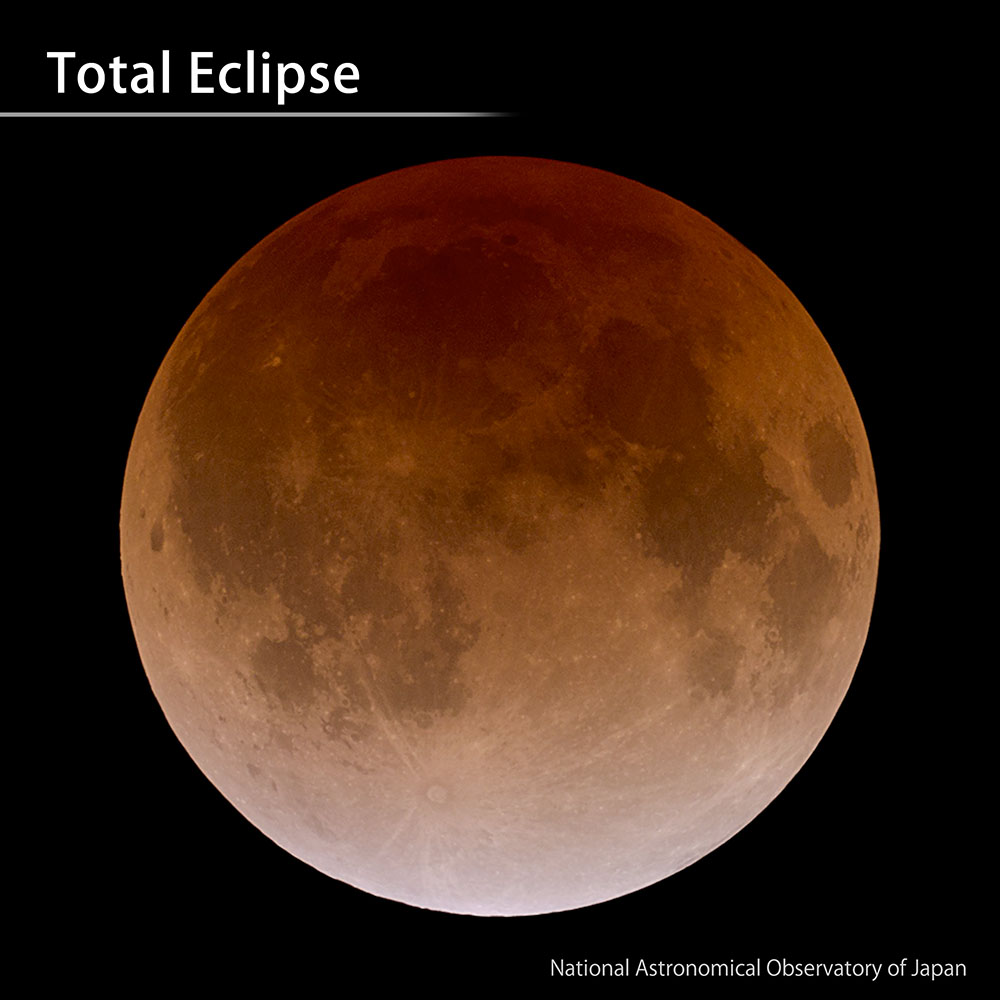Total Lunar Eclipse on January 31 (January, 2018)
Watch a Total Lunar Eclipse January 31
A total lunar eclipse occurs on January 31, 2018. The entire total lunar eclipse from start to finish can be seen from all over Japan. The conditions are good for observing the total lunar eclipse. The Moon starts to be eclipsed at 8:48 p.m. in the east‐southeastern sky and reaches totality at 9:51 p.m. in the southeastern sky. Totality will last 77 minutes (one hour and 17 minutes). During totality, the Moon turns a red copper color instead of turning completely dark. After that, the eclipsed part gradually becomes smaller starting from 11:08 p.m., and the Moon returns to its original round figure at 0:12 a.m. on February 1. You can enjoy the lunar eclipse with the unaided eye. If you have a telescope or binoculars, you can also try observing the eclipse with one of those. Also, during the total lunar eclipse, you can see faint stars without interference from the moonlight. This is another way to enjoy the total lunar eclipse. It is a very cold season, so please take proper precautions against the cold when observing.
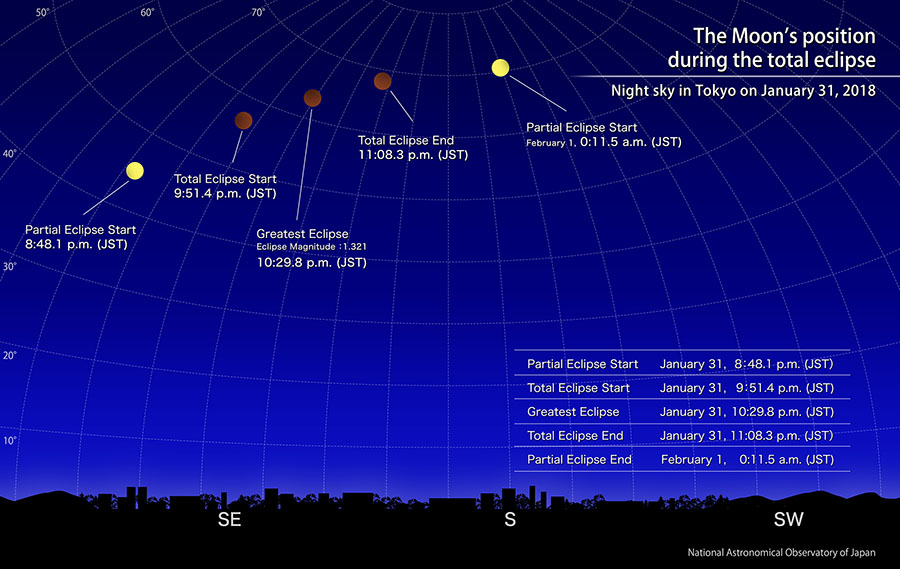
| Time | Eclipse Magnitude (Note. 1) | |
|---|---|---|
| Partial Eclipse Start | Jan. 31, 8:48.1 p.m. | 0 |
| Total Eclipse Start | Jan. 31, 9:51.4 p.m | 1 |
| Greatest Eclipse | Jan. 31, 10:29.8 p.m. | 1.321 |
| Total Eclipse End | Jan. 31, 11:08.3 p.m. | 1 |
| Partial Eclipse End | Feb. 1, 0:11.5 a.m. | 0 |
You can see the appearance of the lunar eclipses from various places with the “Local Prediction of the Lunar Eclipse” by the Ephemeris Computation Office of NAOJ.
(Note 1) Eclipse Magnitude is a numerical value indicating the degree of the eclipse of the Moon. It shows how much of the Moon is in the shadow of the Earth, taking the diameter of the Moon as 1.0. When the eclipse magnitude is more than 1.0, the Moon is entirely eclipsed. Back
When is the Next One?
The next total lunar eclipse is on July 28, 2018. From the Tohoku region and areas further west, you can see the Moon sinking low while the total eclipse is in progress. In other regions in Japan, the Moon sets before totality starts. The next total eclipse that can be seen from all over Japan is the one on November 8, 2022.
How Lunar Eclipses Occur
When sunlight shines on a person or object, a shadow is formed in the opposite direction from the Sun. Likewise, the sunlight makes a shadow of the Earth, which extends in the opposite direction from the Sun. A “lunar eclipse” is a phenomenon where the Moon darkens or looks like it has been chipped as it passes through the shadow of the Earth. We call it a “total lunar eclipse” when the entire Moon enters into the shadow of the Earth.
A lunar eclipse occurs only when the Sun, Earth, and Moon are aligned. This means a lunar eclipse can only occur on the full moon. However, lunar eclipses do not occur on every full moon. This is because the Moon’s orbit is inclined relative to the orbital plane of the Earth. And most times, the full moon skims past to the north or south of the Earth's shadow, without entering inside the shadow.
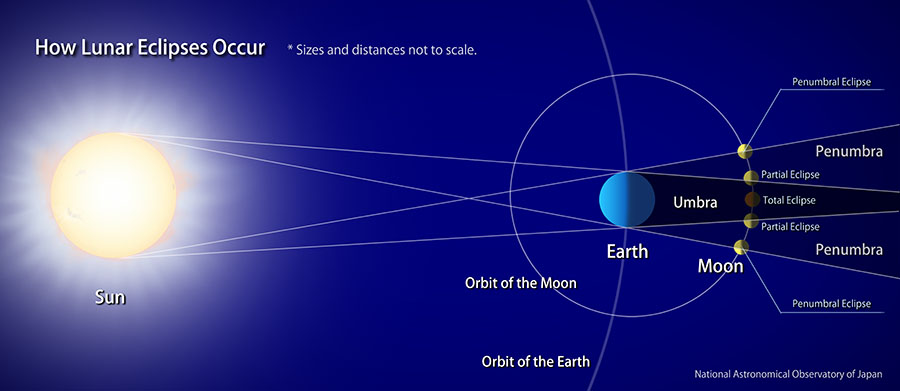
Please watch this video explaining about lunar eclipses.
Types of Lunar Eclipses
The Earth casts two types of shadows, penumbra (light shadow surrounding the umbra) and umbra (dark shadow where the sunlight is mostly blocked). The type of eclipse seen depends on which shadow the Moon enters.
Penumbral eclipse
A penumbral eclipse occurs when the entire Moon or part of the Moon passes through the Earth’s penumbral shadow. Because the penumbra is a dim shadow, it is quite difficult to determine if the Moon is getting darker with the naked eye. But if you look closely, you may notice that the Moon is getting slightly darker on the side closer to the umbra. When photographing with short exposures, you can clearly tell that the Moon is getting darker.
Umbral eclipse
A umbral eclipse is when the entire Moon or part of the Moon passes through the Earth’s umbral shadow. When we say “lunar eclipse,” in most cases it refers to an “umbral eclipse.” The “umbra” is a dark shadow, so the Moon clearly looks like it is chipped.
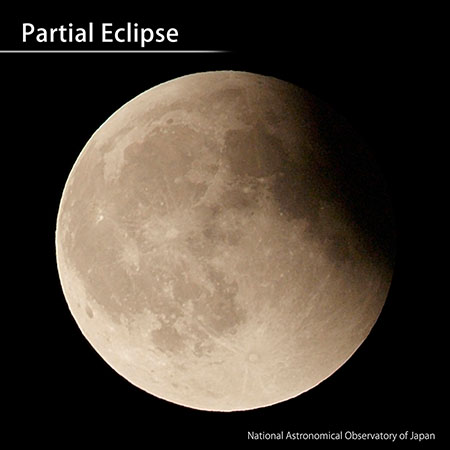
A partial lunar eclipse occurs when only part of the Moon passes through the umbra.

A total lunar eclipse occurs when the entire Moon passes through the umbra.
The Moon’s Passage
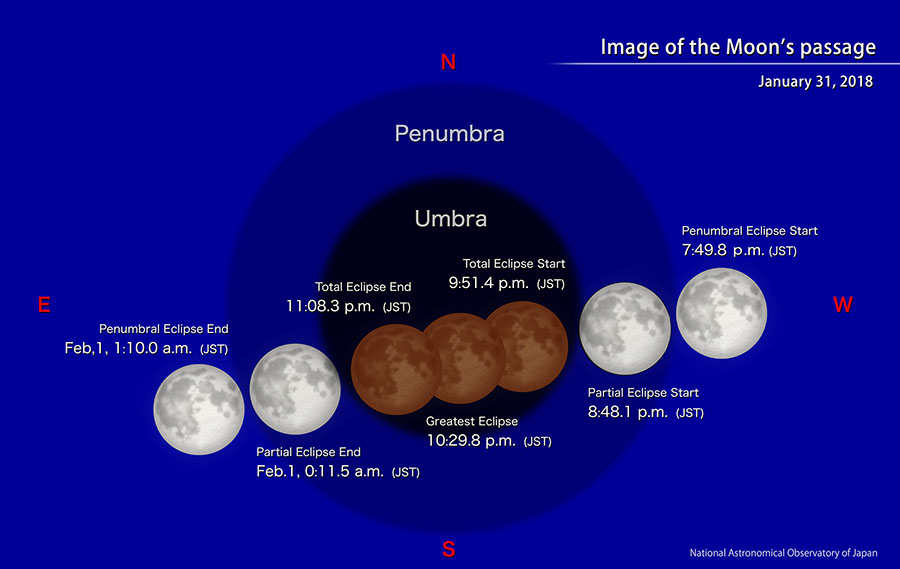
The above image shows the path of the Moon moving through the Earth’s shadow during the January 31, 2018 lunar eclipse. The Moon passes through the Earth’s penumbra to the umbra and back out through the penumbra again, from right to left (west to east).
The “umbra” is the dark shadow where all the direct light from the Sun is obstructed by the Earth. The “penumbra” is a dim shadow where part of the sunlight is obstructed but some sunlight still reaches the Moon. If you were to stand on the Moon while it was in the penumbra and looked at the Sun, you would see that part of the Sun was concealed by the Earth.
